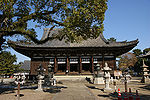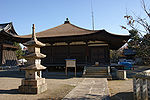
Kakurin-ji (Kakogawa)
Encyclopedia


Tendai
is a Japanese school of Mahayana Buddhism, a descendant of the Chinese Tiantai or Lotus Sutra school.Chappell frames the relevance of Tendai for a universal Buddhism:- History :...
sect in Kakogawa, Hyōgo
Hyogo Prefecture
is a prefecture of Japan located in the Kansai region on Honshū island. The capital is Kobe.The prefecture's name was previously alternately spelled as Hiogo.- History :...
, Japan
Japan
Japan is an island nation in East Asia. Located in the Pacific Ocean, it lies to the east of the Sea of Japan, China, North Korea, South Korea and Russia, stretching from the Sea of Okhotsk in the north to the East China Sea and Taiwan in the south...
.
It was established by Prince Shōtoku
Prince Shotoku
, also known as or , was a semi-legendary regent and a politician of the Asuka period in Japan who served under Empress Suiko. He was a son of Emperor Yōmei and his younger half-sister Princess Anahobe no Hashihito. His parents were relatives of the ruling Soga clan, and was involved in the defeat...
's instruction in 589
589
Year 589 was a common year starting on Saturday of the Julian calendar. The denomination 589 for this year has been used since the early medieval period, when the Anno Domini calendar era became the prevalent method in Europe for naming years.- Europe :* October 17 – The Adige River...
.
Kakurin-ji's Taishidō completed in 1112, and Main Hall
Main Hall (Japanese Buddhism)
Main hall is the term used in English for the building within a Japanese Buddhist temple compound which enshrines the main object of veneration. Because the various denominations deliberately use different terms, this single English term translates several Japanese words, among them Butsuden,...
was completed in 1397. Both are National Treasures of Japan
National treasures of Japan
National Treasures are the most precious of Japan's Tangible Cultural Properties, as determined and designated by the Agency for Cultural Affairs...
.
Building list
- Taishidō - National Treasure of Japan. It was built in 1112.
- Main HallMain Hall (Japanese Buddhism)Main hall is the term used in English for the building within a Japanese Buddhist temple compound which enshrines the main object of veneration. Because the various denominations deliberately use different terms, this single English term translates several Japanese words, among them Butsuden,...
- National Treasure of Japan. It was built in 1397. - Jōgyōdō - Important Cultural PropertyImportant Cultural Properties of JapanThe term is often shortened into just are items officially already classified as Tangible Cultural Properties of Japan by the Japanese Agency for Cultural Affairs and judged to be of particular importance to the Japanese people....
of Japan. It was built in Heian periodHeian periodThe is the last division of classical Japanese history, running from 794 to 1185. The period is named after the capital city of Heian-kyō, or modern Kyōto. It is the period in Japanese history when Buddhism, Taoism and other Chinese influences were at their height...
. - Gyōjadō - Important Cultural Property of Japan. It was built in 1406.
- Bell towerBell towerA bell tower is a tower which contains one or more bells, or which is designed to hold bells, even if it has none. In the European tradition, such a tower most commonly serves as part of a church and contains church bells. When attached to a city hall or other civic building, especially in...
- Important Cultural Property of Japan. It was built in 1407. - Gomadō - Important Cultural Property of Japan. It was built in 1563.
- PagodaPagodaA pagoda is the general term in the English language for a tiered tower with multiple eaves common in Nepal, India, China, Japan, Korea, Vietnam and other parts of Asia. Some pagodas are used as Taoist houses of worship. Most pagodas were built to have a religious function, most commonly Buddhist,...
- It was built in Muromachi periodMuromachi periodThe is a division of Japanese history running from approximately 1336 to 1573. The period marks the governance of the Muromachi or Ashikaga shogunate, which was officially established in 1338 by the first Muromachi shogun, Ashikaga Takauji, two years after the brief Kemmu restoration of imperial...
. - SanmonSanmonA , also called is the most important gate of a Japanese Zen Buddhist temple, and is part of the Zen shichidō garan, the group of buildings that forms the heart of a Zen Buddhist temple. It can be however often found in temples of other denominations too...
- It was built in 1672. - Kannondō - It was built in 1705.
- KodōKodo-In Japan:* The kōdō, Japanese incense ceremony.* Kodo , a taiko drumming group based in Japan.* The Kodo Group, a yakuza criminal organization...
- Shin-Yakushidō

